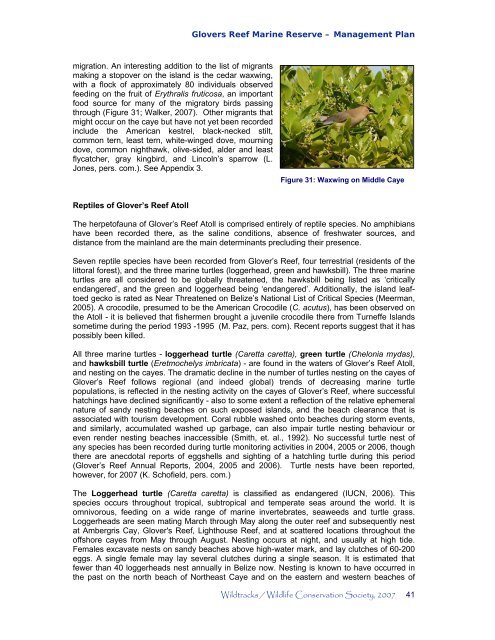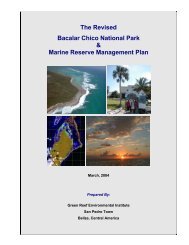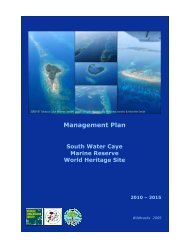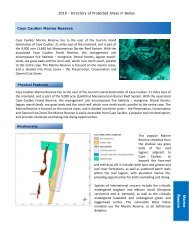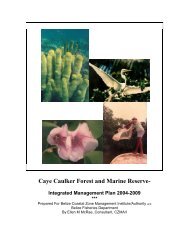Management Plan - Glover's Reef Marine Reserve
Management Plan - Glover's Reef Marine Reserve
Management Plan - Glover's Reef Marine Reserve
Create successful ePaper yourself
Turn your PDF publications into a flip-book with our unique Google optimized e-Paper software.
migration. An interesting addition to the list of migrants<br />
making a stopover on the island is the cedar waxwing,<br />
with a flock of approximately 80 individuals observed<br />
feeding on the fruit of Erythralis fruticosa, an important<br />
food source for many of the migratory birds passing<br />
through (Figure 31; Walker, 2007). Other migrants that<br />
might occur on the caye but have not yet been recorded<br />
include the American kestrel, black-necked stilt,<br />
common tern, least tern, white-winged dove, mourning<br />
dove, common nighthawk, olive-sided, alder and least<br />
flycatcher, gray kingbird, and Lincoln’s sparrow (L.<br />
Jones, pers. com.). See Appendix 3.<br />
Reptiles of Glover’s <strong>Reef</strong> Atoll<br />
Glovers <strong>Reef</strong> <strong>Marine</strong> <strong>Reserve</strong> – <strong>Management</strong> <strong>Plan</strong><br />
Figure 31: Waxwing on Middle Caye<br />
The herpetofauna of Glover’s <strong>Reef</strong> Atoll is comprised entirely of reptile species. No amphibians<br />
have been recorded there, as the saline conditions, absence of freshwater sources, and<br />
distance from the mainland are the main determinants precluding their presence.<br />
Seven reptile species have been recorded from Glover’s <strong>Reef</strong>, four terrestrial (residents of the<br />
littoral forest), and the three marine turtles (loggerhead, green and hawksbill). The three marine<br />
turtles are all considered to be globally threatened, the hawksbill being listed as ‘critically<br />
endangered’, and the green and loggerhead being ‘endangered’. Additionally, the island leaftoed<br />
gecko is rated as Near Threatened on Belize’s National List of Critical Species (Meerman,<br />
2005). A crocodile, presumed to be the American Crocodile (C. acutus), has been observed on<br />
the Atoll - it is believed that fishermen brought a juvenile crocodile there from Turneffe Islands<br />
sometime during the period 1993 -1995 (M. Paz, pers. com). Recent reports suggest that it has<br />
possibly been killed.<br />
All three marine turtles - loggerhead turtle (Caretta caretta), green turtle (Chelonia mydas),<br />
and hawksbill turtle (Eretmochelys imbricata) - are found in the waters of Glover’s <strong>Reef</strong> Atoll,<br />
and nesting on the cayes. The dramatic decline in the number of turtles nesting on the cayes of<br />
Glover’s <strong>Reef</strong> follows regional (and indeed global) trends of decreasing marine turtle<br />
populations, is reflected in the nesting activity on the cayes of Glover’s <strong>Reef</strong>, where successful<br />
hatchings have declined significantly - also to some extent a reflection of the relative ephemeral<br />
nature of sandy nesting beaches on such exposed islands, and the beach clearance that is<br />
associated with tourism development. Coral rubble washed onto beaches during storm events,<br />
and similarly, accumulated washed up garbage, can also impair turtle nesting behaviour or<br />
even render nesting beaches inaccessible (Smith, et. al., 1992). No successful turtle nest of<br />
any species has been recorded during turtle monitoring activities in 2004, 2005 or 2006, though<br />
there are anecdotal reports of eggshells and sighting of a hatchling turtle during this period<br />
(Glover’s <strong>Reef</strong> Annual Reports, 2004, 2005 and 2006). Turtle nests have been reported,<br />
however, for 2007 (K. Schofield, pers. com.)<br />
The Loggerhead turtle (Caretta caretta) is classified as endangered (IUCN, 2006). This<br />
species occurs throughout tropical, subtropical and temperate seas around the world. It is<br />
omnivorous, feeding on a wide range of marine invertebrates, seaweeds and turtle grass.<br />
Loggerheads are seen mating March through May along the outer reef and subsequently nest<br />
at Ambergris Cay, <strong>Glover's</strong> <strong>Reef</strong>, Lighthouse <strong>Reef</strong>, and at scattered locations throughout the<br />
offshore cayes from May through August. Nesting occurs at night, and usually at high tide.<br />
Females excavate nests on sandy beaches above high-water mark, and lay clutches of 60-200<br />
eggs. A single female may lay several clutches during a single season. It is estimated that<br />
fewer than 40 loggerheads nest annually in Belize now. Nesting is known to have occurred in<br />
the past on the north beach of Northeast Caye and on the eastern and western beaches of<br />
Wildtracks / Wildlife Conservation Society, 2007 41


